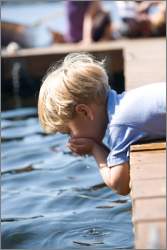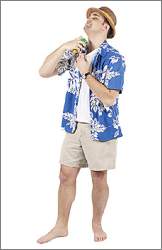|
DEET in Your Drinking Water? What Everyone Needs to Know
by www.SixWise.com
Every year, 100 million Americans slather on insect repellant to enjoy their outdoor barbecues, picnics and activities without getting bitten or stung. However, in the repellants used by about one-third of the U.S. population is a powerful chemical commonly known as DEET.
|

DEET, a neurotoxin, has been detected in lakes and rivers.
|
And as soon as you come inside and wash DEET from your skin and clothing (something the U.S. Environmental Protection Agency (EPA) recommends you do right away), that DEET gets washed down the drain, and is now showing up in rivers and lakes.
According to testing done for the Chicago Sun-Times, DEET is also present in your drinking water.
Thought the amounts detected were low -- 8.3 parts per trillion -- the testing was done during March, when insect repellant use was still low. And according to some experts, this is still cause for alarm.
"This raises a red flag. [When] you have so many people using it, the risk is there," Mohamed Abou-Dania, a professor at Duke University, told the Sun-Times.
DEET is a Neurological Toxin
What makes the finding of DEET in drinking water so concerning is the fact that DEET is potentially very toxic, particularly to children. While the EPA maintains that the chemical is safe when used correctly, studies have shown that when used in high amounts, or for long periods of time, DEET is far from safe.
|

Up to one-third of the U.S. population uses DEET-containing insect repellants.
|
DEET has been shown to cause nervous-system damage, including:
And according to studies by Abou-Dania, while lab rats had no reaction to DEET when it was used for 30 days, after 60 days their brain cells started to die.
Adding to the problem is the fact that DEET does not degrade quickly, nor does it breakdown much as it passes through sewage or drinking-water treatment plants.
Scientists are worried that DEET may collect in the sediment of streams and prove toxic to birds, fish and other wildlife.
|
 All-Natural Flea 'n Tick B Gone repels insects from your backyard using only natural plant resources; it contains NO DEET. All-Natural Flea 'n Tick B Gone repels insects from your backyard using only natural plant resources; it contains NO DEET.
|
"A little bit seems to go a long way in the environment," said Dana W. Kolpin, a research hydrologist with the Geological Survey in Iowa City, Ia., in the Sun-Times.
How Can You Protect Your Family and Remove DEET From Your Drinking Water?
To start, you can consider avoiding all insect repellants that contain DEET. There are others on the market that use only natural essential oils to repel insects, and these do not pose the potential to harm the environment or your health.
All-Natural Flea 'n Tick B Gone is an ideal alternative because it's an enzyme-based formula made naturally from plant resources that you can use as an entirely non-toxic, insect repellant for your backyard. Just mist the area and you'll be tick- and bug-free for at least three hours!
As for your drinking water, the U.S. government doesn't have standards for DEET in your water, though public officials maintain that the water supply is safe.
If you want to be sure, you can have your tap water independently tested to find out what, if any, contaminants exist.
Next, you can use:
1. A high-quality Wellness Kitchen Filter for your home.
The Wellness Kitchen is tested to reduce VOCs, pesticides, and herbicides -- including DEET -- below detectable levels for the life of the filter.
The Wellness Kitchen combines the best filtration and enhancement technologies to deliver the purest and most natural tasting water available. It effectively reduces harmful contaminants, while at the same time enhancing the water with delicate ions and minerals.
2. The Wellness Wand when you're on the go (at restaurants it's both a great conversation piece and healthy for you and others -- all with just a swish through the water in your glass).
The Wellness Wand is a pen-sized water purifier that reduces harmful free radicals like chlorine and chloramines. Simply swirl the wand in your glass for 15 seconds, and you can have peace of mind that it is free of harmful levels of chlorine.
Next, do not overlook one of the primary routes of exposure to tap water contaminants: your shower.
"Taking long hot showers is a health risk," a study in New Scientist reported. "Showers, and to a lesser extent baths, lead to a greater exposure to toxic chemicals contained in water supplies than does drinking it."
Fortunately, chlorine and other chemicals can be easily removed from your family's shower with The Wellness Shower Filter.
As for the DEET, only time will tell just how bad the situation could become.
"The challenge is it's at such a minute level right now that we're trying to forecast what it might become and how we can prevent any further chemicals from getting into our water sources," Suzanne Malec-McKenna, Chicago Environmental Commissioner, told ABC News.
Recommended Reading
Pharmaceutical Pollution: What it is, and How Pharmaceutical Pollution Threatens Your Health
Is There Radon in Your Drinking Water?
Sources
Chicago Sun-Times April 21, 2008
ABC News April 21, 2008
U.S. EPA: The Inset Repellant DEET
|